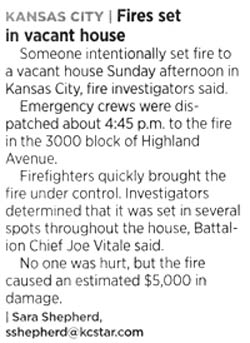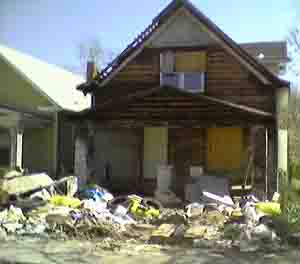This is one of several Fun Pix resulting from my experiences with Habitat For Humanity. |
| B A R E L Y B A D W E B S I T E |
|
This is one of several Fun Pix resulting from my experiences with Habitat For Humanity. |
Wrong One Way |

|
What's wrong with this picture? |
|
In this view east down 33rd Street in the heart of
the Kansas City, Missouri, affiliate of Habitat For Humanity, what's wrong
with this picture is that there are stop signs at an intersection where
both side streets are one-ways the other way. |
|
|
|
I think the city meant for this pair of stop signs to be located the next block east, at Wayne, where 100% of the traffic from the north and 100% of the traffic from the south must enter onto 33rd Street. whether you think I got this wrong, then keep reading, if you want to, about the houses labeled 1 , 2 and 3 .
There's a technique to swinging a sledge, especially when it must be done at a precise angle from a precise place. Any wimp or idiot can use a sledge at all, but when it comes to the application of a precisely angled blow, with the face of the hammer angled precisely at the moment of impact, and then actually hitting the exact target precisely, that's tougher. But when you add in the most important factor -- which is that you want to strike with as much speed and power as possible -- the chance of success drops dramatically. Hammering nails well with a framing hammer is tough enough. Regular people miss the nailhead all the time, and I do too. And although it happens much less often, even real carpenters miss. So is using a sledge well harder? Well, (1) unlike a framing hammer, a sledge requires you to swing from your feet up, not just your shoulder; (2) you probably aren't standing on a firm, flat, dry, level surface; (3) with a sledge your hands are a lot farther away from the target; (4) the sledge weighs seven times more than a framing hammer and ten times more than a regular 16-ouncer; (5) the sledge describes a much larger downward arc than a hammer and takes longer to get there, thus introducing even more chances for error; and (6) introducing yet more chance for error is the fact one of your hands is actually moving along the length of the handle during the downward swing. So yes, using a sledge well is harder. Here's the technique (for a right-hander). (1) Grab the butt end of the handle with your left hand. (2) Holding the handle near the head with your right hand, raise the sledge up in the air and over your right shoulder, then take a beat. (3) If you haven't already done so, position your left foot ahead of your right foot; it's your left foot that will take your weight by preventing your from falling forward after the hammer blow, not your right. (4) When you're positioned just right relative to the target, begin the swing by using your right hand to raise the hammer up away from your shoulder. You want to get the head higher because the longer is the arc of your swing, the more time you have to let your muscles and gravity add up to a more powerful impact. (5) Keeping in mind that at this point your right hand is still up near the head, just as you're about to swing, bounce up onto the balls of your feet a bit in order to get the hammer started down from an even higher elevation. If you've never swung a sledge this might seem like overkill, but if you've swung a sledge a lot you probably don't even realize you do this, but you do do it naturally, every time, and you should. (6) Then just pull that rascal down as hard as you can, using all of your muscles from your legs to your waist to your shoulders to your elbows to your wrists to your hands. As you are doing so, allow your right hand to slide down along the handle toward your left hand. There's a reason a mop handle is round and a sledge handle is not. Whereas a broom or rake or shovel handle is circular in cross section, the handle of a striking tool's is usually oval, with the long dimension parallel to the direction of the strike. When you're swinging a sledge hammer or a framing hammer or an axe or a pick, it's useful to have the tactile feedback through your hands of the orientation of the striking surface, and you couldn't feel that as well if the handle were round. It might surprise you to learn that even though your right arm is the stronger one, most of the sheer power of the blow comes from your left arm. It is your left arm that provides most of the brute downward-pulling strength, whereas your right arm provides more of the steering, more of the delicate, microsecond-by-microsecond adjustments that you make naturally, without thinking about it, without having time to think about it, because all of your mental energy is focused on the target, or it should be. (7) Then just go ahead and finish the swing in such a way that (a) you strike the center of the target, (b) the center of the target is struck by the center of the face of the hammer, (c) at the moment of impact the face of the hammer is parallel to the target, and (d) at the moment of impact the motion of the face of the hammer is parallel to the direction you want to drive the target. (8) Do this over and over again till whatever it is you're whamping on has been whamped on enough, then take a break. (If you're a novice, the rule for driving a stake into hard ground is that when you're quite sure it won't go any deeper, hit it sincerely at least two more times.) Ringing the bell to win the Kewpie doll at the Sledge-o-Matic game at the county fair is 10% strength and 90% technique. That's why they use a short, skinny guy to run the booth. He demonstrates how easy it is to ring the bell, so you figure you can do it too, and you're probably wrong. The difference is that he has learned the technique, and now you have too. The Habitat house labeled 2
,
which is 3232 Highland, is the one I worked on from Tuesday through Saturday
throughout July and August of 2000 as a paid H4H employe The Habitat house labeled 3
was Billy house till he left. Billy Duncan, a long-time Habitat supervisor, was a character. |
|
Update of March 3, 2007: Remember that one bullet hole I mentioned? Here are two pictures of the back of a house I worked on today, a rehab one block away from the Habitat headquarters. |
|
| At right is a close-up of an exit wound (taken under windy conditions just hours
before I got a haircut). In order for this bullet to go clean through the
house, a through-and-through wound, here are the layers, in order, that it had to
traverse: • Vinyl siding |
|
| If you hover your cursor
above, you might be able to pick out the entrance wound.
In this picture you can barely see 17 bullet holes, but there are about 40
altogether. The angle of entry, which is the same as the camera angle, is such that, given the layout of the yard, the shots had to have been fired from within twenty feet or so, and they are all aimed into the master bedroom. Talk about a rude awakening. Immediately north of this Habitat house, which is the direction whence the bullets came, is an apartment house known as a "gang building." One lovely winter day in 2000 I was driving past it when I was startled by an adult female on the street side of a car parked thereinfrontof, apparently talking to the driver. She originally caught my attention because she was jumping up and down. She caught it further when I realized, as I drove closer, that she was buck-naked. Update of March 31, 2007: I helped redo the ceiling of the front porch of this 1992 house today, and when I pulled off the old soffit I discovered that all the framing members and roof sheathing in the attic were covered in soot. When I mentioned this to the new homeowner (Hi, Monique), who'd already gotten to know some of her soon-to-be neighbors, she said that didn't surprise her, that the house had suffered fire damage. Except what she said was, and I quote, "Yeah, I know. It's been set on fire three times." Not caught fire, mind you, but set on fire. Three times. Maybe I've just been lucky, but I almost always go a lot longer than five years between episodes of someone's setting my house on fire. |
|
| Here's a story of a different house on fire, one that proves the
"unlucky three on a match" theory. Some months back this
particularly vicious and vengeful gang-banger
(who shall remain nameless because I am not one) decided to "move into"
a vacant house two doors down from a Habitat house I worked on
today on Highland. This individual was, as they say, "well-known to the
police." He was, according to my understanding, a thoroughly
intimidating and awful example of humanity, a violent, drug-dealing,
sociopathic predator. So, also probably not a good neighbor. A few weeks later "his" house managed to catch fire while he was asleep inside. The fire department, along with the police, arrived immediately and put out the fire. The guy kept living there, and a few weeks later his house managed to catch fire again, and again the fire department responded immediately and doused the fire.
Shortly after that the thug became the stand-out suspect in the murder of a neighborhood girl, but the police couldn't prove enough. Shortly after that his house managed to catch fire again, and the police were called. Extremely shortly after that, unluckily, the fire department turned out to be really busy, and the result is shown in the photo I took, at right. It's like a yard sale in which the price of everything is zero. |
 |
 |
| Update of April 7, 2007: Remember the Forty-Bullet-Hole
Habitat house? I worked on it again today breaking up few tons of
concrete driveway, and this time I got to play with a new power tool, a
jackhammer. You wouldn't think such a simple-minded and brutal
tool would require much in the way of technique, but it does. When you get it
started on a new sector of concrete you have to lift or drag it into
just the right spot at just the right angle, then you have to push down just right. Push down too
hard and the chisel grinds rather than hammers. Push down too
soft and the chisel skids and dances all around. Get everything
just right and you can chew off just the right size of concrete pretty
efficiently.
The morning sunlight is from the left, and the four parts of the "frame" are an extremely foreshortened view of the four sides of the opening from the room's ceiling up to the skylight lens. The speckles are the "popcorn" treatment of the little sheetrocked "walls" leading up from the ceiling to the roof. The background of the weird art is what the plexiglass looks like today. And it got this way because, where you see the blue crosses of what turns out to be painter's tape, whose purpose is to keep out the rain, there are in fact two bullet holes. This room has a second skylight, and it too has two bullet holes in it, so I guess this is the Forty-Four-Bullet-Hole Room. Can you imagine the circumstances under which you would think it's a pretty good idea to let rip with a couple bullets into a skylight? I can. |
| Update of August 18, 2007: A nice man named Fasika and
his nice family are scheduled to move into this Habitat house in two
weeks. The air conditioner condenser was delivered to its new
home and installed on its concrete pad yesterday, and it was turned
on to cool the house for lots of painting today.
According to the site supervisor, John Gartin (shown at right inspecting the remains of the corpse), the thieves wanted the copper therein. When I wondered why they didn't take the entire unit, he said they probably didn't know how to fence it. An innocent, new-born condenser worth $1,000 in parts and labor sacrificed for maybe $25 worth of copper. What a world. |
| B A R E L Y B A D W E B S I T E |
|